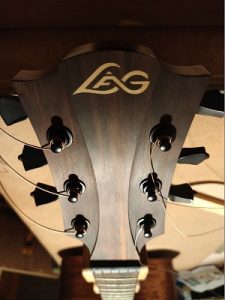

This beauty was being shipped outstation to its owner when an in-transit mishap caused a massive break in the top board. Though in two parts, the break, thankfully, was along the grain of the wood and in one plane.
This France-made guitar, available only at a single outlet in Lucknow, was being shipped by the local dealer to the customer who had bought it. Just going by the way the top had broken open, it would be safe to surmise that something heavy had been thrown – and not just kept – on top of the box containing the guitar.
In defence of the dealer, the instrument was in its case and in two cardboard boxes, and separating the two boxes were stacks of newspapers, specifically to avoid such an eventuality!


For those who are not being able to make out from the photographs above, this is the treble side of the guitar: below the shoulder of the guitar and (right) in the same plane, in the lower bout.
A little something about this instrument: this was the T88D from the house of LAG, an all-wood instrument with a solid, AAA Engleman Spruce top, with back and sides of solid honey Khaya (one of the five species in the Mahogany family). The elegantly designed and clean lines of the headstock and bridge were represented in Brownwood. The fretboard too was Brownwood (read about what this is in next week’s post).
The first order of business was to see whether the two sides along the cracks matched up and came together seamlessly. If they did not, it would be quite a job, removing the offending shards of wood, bringing the two planes together, and then filling the gap created with slivers of spruce wood. Just the thought of that rigour made me sweat!
When I pulled the two seams together, they did come together without a problem but without an external force acting on the two sides, they returned to their original position. What that meant was that while glueing, the two sides would need to be propped up in such a way that the joint was a seamless one.
I took wooden dowels thick enough and long enough to stand up inside the guitar, with a piece of wood wrapped in butter paper above them, used to level the two sides. With proper wood glue shot into the crack, the rods pushing against the butter-paper-wrapped piece of wood, it was time to wait patiently to see how the guitar would heal up.
It healed up fine but to make doubly sure, I decided to cleat the crack too. Cleats are little pieces of the wood that help hold two sides of a break and are put from the inside of the guitar. They must be of the same wood as the one in which the crack has developed, only, care has to be taken that while cleating the crack, the grain orientation of the cleat should be opposite to what it is in the area of the crack.

This is just to show you where the cleats are on the inside of the guitar, since I couldn’t show you inside the guitar.
The instrument was now structurally sound. Needed now were some cosmetic touches. So, I took some superthin cynoacralyte glue and ran a bead down the length of the crack. While the CA glue added strength and sealed whatever little opening there was, it needed to be sanded down and polished to come in level with the rest of the top.
Nothing that #2000, #3000, #4000 and #5000 sandpaper wouldn’t do but then these had to be soaked in water overnight for them to function right.

To minimise the area which would be acted upon by these, I taped off the affected area and worked within the confines of the taping. A large eraser served as the perfect sanding block.

After four grits of sandpaper worked their magic, you couldn’t feel a thing if you ran your hand over the surface of where the break once was.
Re-stringing this beauty, I could not help be amazed by the mellow strains it produced. Beautiful indeed!
Don’t forget to catch next week’s post when I review the LAG T88D!

My all compliments to you for your skill and perfection over guitar repair.. It is nothing short of an art..
Thank you for the glowing compliment, Major!
Awesome sir.pls share the full picture of french guitar.
Next week